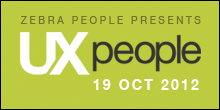“Seeding UX into the DNA of an organisation” - Mel McVeigh at UX People

Last week I helped host Zebra People’s UX People, a day long conference featuring talks and practical workshops from the likes of Cennydd Bowles, Christopher Lee Ball and Oli Shaw. You can download all of my notes from the day in an ebook for iBooks, for Kindle or as a PDF. On the blog I’ve already published my notes from talks by Christopher Lee Ball speaking about “Experience Principles”, and Jonty Sharples imploring us to “Test or be damned”.
Here are my notes from the third talk of the day - Mel McVeigh sharing some lessons from building a digital product development and user experience team at a very analogue publishing business.
“Seeding UX into the DNA of an organisation” - Mel McVeigh
I really enjoyed Mel McVeigh’s talk at UX People. She was describing how she had come to forge a team doing UX and design at Which?. I couldn’t help but think of some of the parallels with arriving at the Guardian as their first ever “Information Architect” in the technology team, and going on to try and build out the space where user-centred design work could be done.
Mel explained that Which? had started from a low base - every digital product had been out-sourced, including the design of it. Which? were, she said, not a “sinking ship” like a lot of publications, but they also weren’t a “confident” digital brand. They are under a lot less pressure than other publishers because they have a big subscriber base for their print product, which means they cover their costs despite not having a physical presence in newsstands. But digital is transforming their audience expectations, and their most recent rebrand had only a tiny little bit on the last page about digital.
Mel said that as a team leader she wanted to create an environment “where people can thrive”, and pointed out that people are “a mash-up of all the things that influence us. I take the influence of all my previous jobs to work with me every day.” She also said “If you are bored, then I think you make boring stuff”, which is a sentiment I entirely endorse. My colleague Karen Loasby used to have as the tag line on her IA Play blog the brilliant phrase “because bored people make bad decisions.”
Mel’s strategy had been to “put making and thinking together” and to try and create a space where there is excitement and buzz about what is being designed and built, rather than making people scared of digital and of change. They had deliberately steered away from tackling the big old redesign of the website, and instead worked on a new product where they could have the most effective influence. “If we did that product right”, Mel said, “we knew that the business would come to us to do more.”
As I said, I was struck by many echoes of what I’d tried to do at the Guardian, where instead of battling to get heard on big projects, at times it was better to concentrate on doing really good work on standalone things, and then wait for the big projects to realise the type of work and insight that they were lacking.
In her talk Mel illustrated some really nice ways of working. Her team do a fortnightly “pop-up pub” in the office. Everybody from the business can drop in, grab a free beer, and then take in some of the work the digital product team are doing. They’ve found this social element helps break down barriers between marketing, editorial and product. The sketches and wireframes on display also help demonstrate the iterative approach to design, getting the whole business ready for a looser more agile way of working.
They regularly have “product design jams” at Which?, where they spend a couple of hours working up new ideas and preparing to pitch them. This isn’t so much to drive new product development, Mel said, but to rehearse the decision making and pitching skills that you need to win with stakeholders. She also suggested that going on a story-telling course is probably more useful (and fun) than going on a standard “how to do presentations” business management style of thing. As she said, with product design, “the craft can be amazing, but if the pitch is poor...”
She also gave us some really good ideas for personal development, and how to get hired. She said that two key questions she always asks in interviews are “what inspires you?” and “what is your hidden talent?”
Often the side activities of someone can be a great clue as to the additional skills and experience they will be bringing into the mix at work. I was reminded of the “In Praise of Side Projects” talk by Alexander Baxevanis at London IA, where it suddenly dawned on me that my entire career was now based on the side project of re-building the website of the record shop I used to work for.
Next...
In the last of these notes from UX People I’ll have what I took away from a very thought-provoking talk by Cennydd Bowles about “What Comes After UX?”
This is one of a series of blog posts about UX People 2012. You can download all of my UX People notes in an ebook for iBooks, for Kindle or as a PDF.
“Experience Principles” - Christopher Lee Ball
“Test or be damned” - Jonty Sharples at UX People
“Seeding UX into the DNA of an organisation” - Mel McVeigh